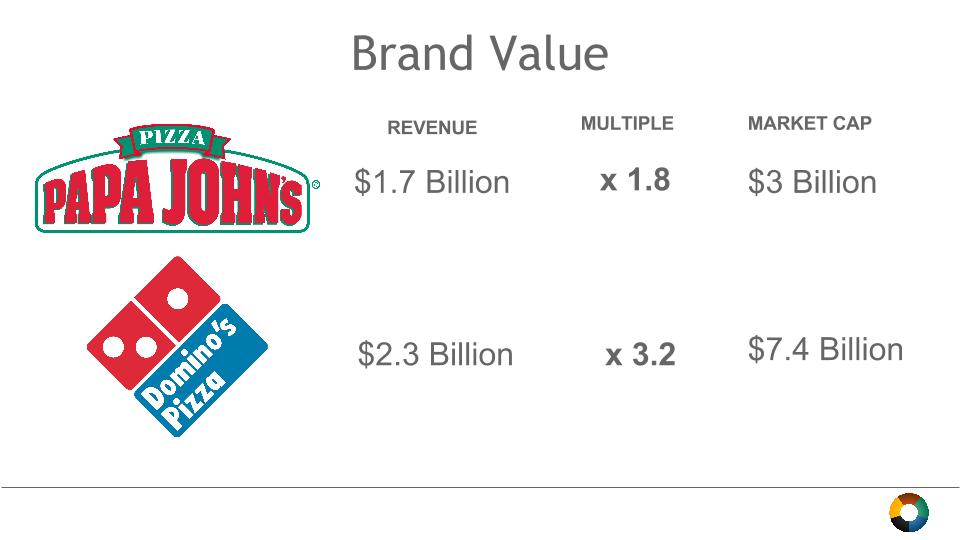
:max_bytes(150000):strip_icc()/dpz1-84f0e5b309aa49e2916d9613823d79f0.jpg)
Part of Domino's stellar returns to date was by gaining a premium valuation, and I don't foresee that happening again since its valuation is already high.ġ0 stocks we like better than Domino's Pizza But I'll stop short of calling the stock a millionaire-maker, especially over the limited time frame of the next 10 years. So Domino's can indeed grab more market share.Īll of the ingredients are there for Domino's business to be a market-beating investment. Smaller competition isn't likely faring as well. Domino's, with its delivery-driven model and digital expertise, was built to withstand the COVID-19 challenge. comparable-sales growth, even though sales for the restaurant industry were markedly down. Domino's preliminary results for the second quarter showed an outstanding 14% U.S. Recent results give credibility to this hypothesis. The circumstances aren't cheery, but Domino's could gain market share by filling the void. restaurants could close in the next few months, and one would imagine pizza restaurants aren't immune. Restaurant-reservation company OpenTable's CEO believes 25% of U.S. That leaves a lot of small operations with a major slice of the, ahem, pie. According to Domino's, the top four QSR pizza chains only have a combined 47% U.S. It already claims to have 15% of the global marketshare.īut think about this. And it's fair to question how much more market share Domino's can take anyway. The final business key from the past was gaining market share by improving its pizza. So Domino's can grow revenue and profits and reduce its share count. Furthermore, it's spent an average of $636 million annually on share buybacks the last four years, and it plans to keep reducing its share count going forward. Since Domino's employs a franchise operating model, higher retail sales deliver operating leverage for the company, improving profits. That's 47% unit growth, and 75% retail-sales growth from the end of 2019, comparable to its growth pace over the past 10 years. It's targeting 25,000 locations and $25 billion in retail sales by 2025. Most of what made Domino's a big winner over the past decade might still apply going forward.ĭomino's growth plan, developed prior to the coronavirus, hasn't changed. But this increased valuation is another reason the stock is around a 30-bagger over the past decade. It now trades at over four times sales, and over 36 times earnings - pricey for a restaurant stock. It went from perpetually trading in the bargain bin to commanding the premium valuation of a top growth stock. However, this solid business execution also attracted investors' attention to the stock.

Now, it has fewer than 39 million - a 35% reduction.īetter pizza, growing revenue, improving profits, and a reduction in share count all contributed to Domino's millionaire-making gains. At the end of 2010, it had 60 million shares outstanding. With its newfound cash, Domino's rewarded shareholders by systematically reducing its share count. In 2019, profitability was much improved, with a 39% gross profit margin and an 11% net profit margin. In 2010, the gross profit margin and net profit margin were just 28% and 6% respectively. Not only have sales increased, but the company is also more profitable.

From the start of 2011 through the end of 2019, the company's global restaurant count has gone up 82%, and its global retail sales have increased by 128%. In other words, Domino's gained market share with an improved product, not new locations.Įquipped with a better pizza, Domino's was off to the races. quick-service restaurant (QSR) pizza sales only grew 1.7% during this time. Consider that, according to Statista, U.S. In the U.S., it only added two net new restaurant locations from 2009 to 2010, but its U.S. After all, its pizza wasn't very good at the time.ĭomino's admitted it had a poor product and launched a new pizza recipe in 2010. The company's sales soared as a result. That cheap valuation reflected Wall Street's low confidence in Domino's business. From 2009 through 2010, the stock traded below sales, and its price-to-earnings ratio was consistently below 10. In 2010, investing in Domino's would have been a contrarian move. DPZ data by YCharts How Domino's made millionaires


 0 kommentar(er)
0 kommentar(er)
